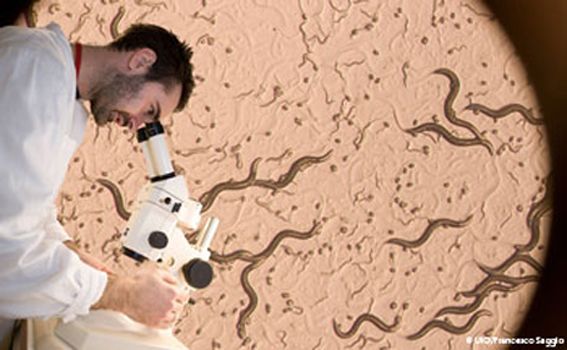Research focus
DNA repair is the main interest in the group. The term DNA repair covers many different mechanisms that remove damaged or inappropriate bases from DNA. Historically, studies of DNA repair has been motivated by the need for these mechanisms in order to prevent mutations - changes in the genetic code.
But DNA repair enzymes have many other important functions in cells that are vital for basic cellular functions. For example, you would not be able to make antibodies without DNA repair.
DNA repair enzymes also contribute to regulation of chromatin architecture, regulation of gene expression, and in RNA quality control. Through these diverse functions, DNA repair protect us from disease and affect how we age.
Aims:
- To study whether DNA damage drive cancer development and determine response to cancer therapy
- To study how DNA repair mechanisms protect us from aging and age-related diseases
Key research achievements
- We have uncovered mechanisms by which failure to repair nuclear DNA can lead to progressive mitochondrial dysfunction and neurodegeneration (SenGupta et al., 2021; Fang et al., 2014; Fang et al 2016)
- We have demonstrated that the DNA repair enzyme SMUG1 contributes to gene regulation and RNA quality control (Kroustallaki et al., 2019; Jobert et al., 2013)
- We have described how base excision repair enzymes UNG and SMUG1 contribute to tumourigenesis (Serebrenic et al., 2019; Safavi et al., 2000) and shape the response to chemotherapy (SenGupta 2013; Dengg et al., 2016)
Key publications
DNA repair and healthy ageing:
-
SenGupta T, Palikaras K, Esbensen Y.Q, Konstantinidis G, Naranjo Galindo FJ, Kavya Achanta K, Kassahun H, Stavgiannoudaki I, Bohr VA, Akbari M, Gaare J, Tzoulis C, Tavernarakis N, Nilsen H, (2021) Base excision repair causes age-dependent accumulation of single-stranded breaks that contributes to Parkinson’s disease etiology. Cell Reports 36(10):109668
-
Fang, Evandro Fei; Kassahun, Henok; Croteau, Deborah L.; Scheibye-Knudsen, Morten; Marosi, Krisztina; Lu, Huiming; Shamanna, Raghavendra A.; Kalyanasundaram, Sumana; Bollineni, Ravi Chand; Wilson, Mark A.; Iser, Wendy B.; Wollman, Bradley N.; Morevati, Marya; Li, Jun; Kerr, Jesse S.; Lu, Qiping; Waltz, Tyler B.; Tian, Jane; Sinclair, David A.; Mattson, Mark P.; Nilsen, Hilde & Bohr, Vilhelm A. (2016). NAD+ Replenishment Improves Lifespan and Healthspan in Ataxia Telangiectasia Models via Mitophagy and DNA Repair. Cell Metabolism. ISSN 1550-4131. 24(4), s 566- 581 . doi: 10.1016/j.cmet.2016.09.004
RNA quality control and gene expression regulation:
-
Kroustallaki, P., Lirussi, L., Carracedo, S., You, P, Esbensen Q.Y., Götz, A., Jobert, L., Alsøe, L., Sætrom, P., Gagos, S., Nilsen, H. (2019) SMUG1 promotes telomere maintenance through telomerase RNA end processing. Cell Reports 28, 1690-1702.
-
Jobert, Laure; Skjeldam, Hanne Kim; Dalhus, Bjørn; Galashevskaya, Anastasia; Vågbø, Cathrine Broberg; Bjørås, Magnar & Nilsen, Hilde (2013). The human base excision repair enzyme SMUG1 directly interacts with DKC1 and contributes to RNA quality control. Molecular Cell. ISSN 1097-2765. 49(2), s 339- 345 . doi:10.1016/j.molcel.2012.11.010.
Mouse models and cancer:
- Safavi, S., Larouche, A., Zahn, A., Patenaude, AM., Domanska, D,. Dionne, K., Rognes, T., Dingler, F., Kang, S.,; Liu, Y., Johnson, N., Hébert, J., Verdun, RE., Rada, C., Vega, F., Nilsen, H., Di Noia, J (2020) The uracil-DNA glycosylase UNG protects the fitness of normal and cancer B cells expressing Activation Induced Deaminase. Nucleic Acids Research – Cancer 2,1-16 . doi: 10.1093/narcan/zcaa019
- Serebrenik, A.A., Starrett, G.J., Leenen, S., Jarvis, M.C., Shaban, N.M., Daniel J. Salamango, D.J., Nilsen, H., Brown, W.L., Harris, R.S., (2019) The deaminase APOBEC3B triggers the death of cells lacking uracil DNA glycosylase. Proc. Natl. Acad. Sci. 116(44):22158-22163.
- Alsøe, L., Sarno, A., Carracedo, S., Domanska, D., Dingler, F., SenGupta, T., Tekin, N.B., Lirussi, L., Jobert, L., Alexandrov, L.B., Galashevskaya, A., Rada, C., Sandve, G.K., Rognes, T., Krokan, H.E., Nilsen, H. (2017) Uracil accumulation and mutagenesis dominated by Cytosine deamination in CpG dinucleotides in mice lacking UNG and SMUG1. Scientific Reports, 7(1): 7199
- Nilsen, Hilde; Rosewell, I.; Robins, P.; Skjelbred, Camilla; Andersen, Sonja; Slupphaug, Geir; Krokan, Hans Einar; Lindahl, T. & Barnes, D.E. (2000). ) Ung-deficient mice reveal a primary role of the uracil-DNA glycosylase enzyme during DNA replication.Molecular Cell. ISSN 1097-2765. s 1059- 1065
